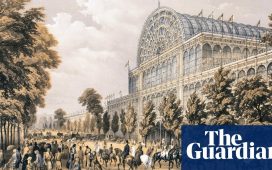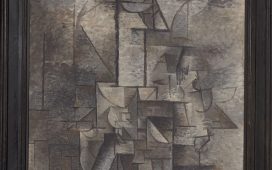At the National Gallery’s vast new Van Gogh exhibition, visitors will be able to see a painting of 1889 whose title, Undergrowth, speaks not of sunflowers, but of untrammelled weeds – and by extension, perhaps, of the dense scrub of the unconscious. Born of his fascination with the raggedy garden of the hospital at Saint-Rémy, to which the artist had admitted himself after several breakdowns, this picture is covered all over by ivy – a rapacious thug of a plant, sinister and bullying. The ground has long since been carpeted, and now the trunks of the trees, clustered together here as if in solidarity, are also on their way to full colonisation, the vines creeping ever upwards. Some small patches of the scene are miraculously dappled with sunlight, but the feeling overall is one of viridescent doom. The longer I looked, the more breathless I felt: as if I, too, were being strangled.
A certain wooziness may, though, be a natural consequence of a show like this. In its entirety, it’s almost too much. The first major exhibition at the National Gallery to be devoted to Van Gogh – its staging marks the gallery’s bicentenary – it comprises no fewer than 61 works, almost every one of which is worth 10 minutes, at least, of your time (if only). What incredible loans. Portrait of a Peasant (1888), a painting of an old gardener, Patience Escalier, with a green-tinged beard, has never before left the Norton Simon collection in Pasadena, California. The Philadelphia Museum of Art has sent Sunflowers (1889), enabling it to hang beside the National Gallery’s Sunflowers (1888) for the first time since they were in the artist’s studio; together with La Berceuse (The Lullaby, 1889), which has travelled from the Museum of Fine Arts, Boston, these form a triptych, as the artist always intended. Among several pictures from private collections, meanwhile, is Trees in the Garden of the Asylum (1889), a gorgeously restrained painting whose framing device – more tree trunks, this time cropped at both ends – speaks richly of Van Gogh’s admiration for Japanese woodblock prints.
How to deal with such repletion? The only way to do it is to put aside all thoughts of Van Gogh the man, the better to truly look at what is before you – an approach the exhibition’s tight-lipped curators encourage. On the walls you’ll find only titles and dates (to know more, you must look up each painting in a booklet): a minimalism designed to allow one’s thoughts and feelings to flow freely, unimpeded by talk of bloody ears and gunshot wounds.
And if the show’s title, Poets & Lovers, seems a touch spurious, even confusing – Van Gogh was not, in the period it covers, hanging out with poets; for companionship, he relied on a brothel, not a partner – its parameters are strict. Here are two prodigious years. In February 1888, Van Gogh arrived in Arles from Paris. In the time that followed, he produced close to 200 paintings and countless drawings, in spite of – or perhaps because of – the fact that for 12 months of this he was in the Saint-Paul-de-Mausole asylum in nearby Saint-Rémy. Two months after leaving the asylum, he returned north to Auvers-sur-Oise, near Paris, where he died by his own hand in July 1890.
The temptation is always to see madness in this work: the manic energy that Gauguin, with whom Van Gogh briefly shared the Yellow House in Arles, would describe as a train “hurtling along at top speed” (a crash, Gauguin sensed, was inevitable, and so he scarpered). This exhibition would rather we focus our attention on the artist’s innovation, particularly his experiments with colour (“I believe in the absolute necessity of a new art of colour,” he wrote to his brother Theo in 1888). But the lesson here is that even as you push away the biography, the walls are apt to close in. Landscapes are not merely transformed; they are reinvented.
At the show’s every turn are ordinary things turned strange and monstrous: olive trees that twist in agony; a vineyard that might be teaming with snakes; mountains that would crush a man if they were to move any closer (in Van Gogh, everything moves, all the time). In Oleanders (1888), we’re at first seduced by the pink flowers in a blue jug. Look closer, however, and you see that a novel by that great miserabilist Zola is on the table beside them – and then you remember that oleanders are poisonous.
There are many gardens: “nests for lovers”, in Van Gogh’s eyes (though nest to me is an ambiguous word, for it makes me think of vipers). Sometimes, they appear benign. In Path in the Park, Arles (1888), parasols signal gentle strolling. Roses (1889) deploys impasto and violently deft brushstrokes to capture pale petals whose scent you can almost smell. More often, though, they are melancholy, even menacing.
In the gallery, The Park of the Hospital at Saint-Rémy (1889) seemed heavily symbolic to me, in spite of my own efforts and those of the curators to keep my mind wide open. A sorry stump of a tree; arid, rust-red earth: I told myself not to view these things as a kind of apocalypse. But Van Gogh is plain-speaking. He doesn’t whisper, ever. And sure enough, when I got home, I read a letter in which he writes about this picture to the artist Émile Bernard. First, he likens the tree, a victim of lightning, to “a proud man brought low”. Then, he tackles his colours.
“You’ll understand,” he says, “that this combination of red ochre, of green saddened with grey, of black lines that define the outlines, this gives rise a little to the feeling of anxiety from which some of my companions in misfortune often suffer…” In the end, you can only conclude that you are not, after all, reading too much into anything – though this isn’t to say I’m not grateful for having been given the chance to see Van Gogh anew. These are amazing paintings – masterpieces by any other name. How they quaver, as if a breeze was blowing through them. But they’re not easy, however well known many of them may be. Gathered together, the effect is sometimes as oppressive as it is enlivening. The eyes ache, and so does the heart. It is an unmissable, once-in-a-lifetime show, but I didn’t precisely enjoy it.








